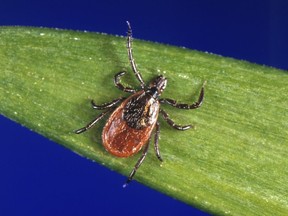Anaplasmosis can cause fever, headache, muscle aches, chills and severe respiratory illness, among other symptoms. If not treated, it can be life-threatening.

Article content
At a time when tick populations are increasing, the Ottawa area is becoming a hotspot for one of the lesser-known illnesses spread by black-legged ticks.
Anaplasmosis can cause fever, headache, muscle aches, chills and severe respiratory illness, among other symptoms. If not treated, it can be life-threatening, especially in people with compromised immune systems. It is less common than Lyme disease, also spread by black-legged ticks. Both are treated with antibiotics.
Advertisement 2
Story continues below
Article content
Those are two of the potentially severe illnesses spread by ticks that are now being closely monitored by public health officials in Ontario as disease-carrying ticks spread through the province. They also include babesiosis, a bacterial infection, and Powassan virus, a rare disease that causes encephalitis and severe illness.
There are many health benefits from being active and outdoors during warm weather, says Emily Morrison, program manager of environmental health at Ottawa Public Health, “however, if you will be in outdoor areas suitable for black-legged ticks, it is important to be aware of the risks of ticks and tick-related diseases, and how to protect oneself.” Tick habitats include wooded areas and areas with tall grasses.
Lyme disease has long been reportable to local public health for investigation and cases have been rising as black-legged ticks become more common across greater areas of the province. Anaplasmosis, babesiosis and Powassan virus were added to the province’s Health Protection and Promotion Act as of last July 1 as diseases of public health significance.
Advertisement 3
Story continues below
Article content
The growing scrutiny of tick-borne illnesses follows the increasing spread of ticks in Ontario, in part due to climate change.
Anaplasmosis was considered rare in the province until fairly recently. Now, according to Public Health Ontario, it is becoming more common in Eastern Ontario, including in Ottawa. The Kingston area has the highest rates in the province, followed by Ottawa and the Leeds-Grenville and Lanark district.
Between July 1 and Dec. 31, 2023, 14 Ottawa residents had confirmed or probable anaplasmosis infection, according to Ottawa Public Health. Seven of the people infected reported that they were exposed to the tick in Ottawa. The other half reported exposure in surrounding areas, including Perth. Those 14 cases were among 40 cases reported throughout 2023 across Ontario, according to Public Health Ontario. All of the cases reported in Ontario were in Eastern Ontario.
There were no cases of anaplasmosis reported in Ottawa during the first three months of the year.
In order to transmit the bacterium that causes anaplasmosis, ticks have to be attached to a person for between 12 and 24 hours. In the case of Lyme disease, it is spread after ticks are attached for at least 24 hours. Unlike Lyme disease, which is often marked by a telltale bull’s-eye rash, there is usually no rash associated with anaplasmosis.
Advertisement 4
Story continues below
Article content
Lyme disease, caused by the bacterium Borrelia burgdorferi, takes its name from Lyme, Conn., where the full range of the disease was first described in 1975. It began to be reported in Canada in the late 1980s and has increased since then as ticks expand further north, assisted by warmer winters.
Between January and March of this year, there were 60 cases of Lyme disease reported in Ontario, a rate of 3.8 per million of population. That is significantly higher than the five-year average for Ontario, which is 43, for the same time of year, a rate of 2.9 per one million population, according to Public Health Ontario.
Early symptoms of Lyme disease can include the rash as well as fever, chills, fatigue and swollen lymph nodes, among other symptoms. If untreated, the disease can spread to the joints and the nervous system, causing severe chronic illness in some cases.
Babesiosis, also transmitted by black-legged ticks, is less common in Ontario than anaplasmosis. In 2023, there were 15 reported cases, a total of four were reported in the Kingston and Hastings area, but there were none reported in or closer to Ottawa.
Advertisement 5
Story continues below
Article content
Babesiosis also causes flu-like symptoms and can lead to severe, even life-threatening, illness.
Powassan virus, which was first discovered in Ontario in 1958, can cause encephalitis, leading to severe illness and death. The virus, for which there is no treatment, remains rare, although there have been reports of case counts increasing in the North Eastern U.S. and elsewhere. There have been about 25 cases reported in Canada since it was identified.
In 2021, Ottawa’s MaryAnn Harris developed encephalitis after been bitten by a tick in Ottawa that transmitted Powassan virus. She was placed on life support. She is now receiving palliative care, according to a recent update from her husband, fantasy writer Charles de Lint.
Ottawa Public Health recommends people apply insect repellent containing DEET or icaridin to exposed skin and clothing, wear long pants, a long-sleeved shirt, shoes and socks, and tuck their pants into their socks. It also recommends wearing light-coloured clothing to spot ticks more easily, doing a full body check after coming inside and staying on trails as much as possible.
Our website is your destination for up-to-the-minute news, so make sure to bookmark our homepage and sign up for our newsletters so we can keep you informed.
Recommended from Editorial
Article content


Comments